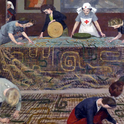Click here to read more from our November 2016 issue
Cabbage White butterflies fluttered along a row of brassicas, big tough verdigris outer leaves, interior shaded milk jade to tender neon.
“It is a variety called the petit-vert,” said Asafumi Yamashita as he gave us a tour of his garden farm on the edge of the Paris suburbs at the end of September. “It is a mix between kale and brussels sprouts. A Japanese farmer created it 20 years ago, but he wouldn’t sell his seeds. Eventually I convinced him. They are very difficult to cultivate, these are probably the only ones in Europe.”
Yamashita is an original outlier, a Japanese transplant who has become the most famous and celebrated maraîcher, market gardener, in all of France. He sells his vegetables to only seven chefs, all of them Michelin starred. “For an average chef,” Yamashita told me, “because my vegetables are so good, cooking with them is very easy. But for a great chef it is very difficult. A great chef wants to express himself, his personality, his ideas and thoughts. It can take them two or three years to figure out how to deal with my vegetables. They are facing something larger than themselves. It is like facing God.”
Yamashita is in his early sixties, longish hair raked back with his fingers, relaxed and friendly; he wore an old t-shirt spotted with dirt. His garden is less than an acre of polytunnels off a path of trodden nettles littered with coils of hose, buckets and piles of wooden stakes. We bent to examine rows of edamame, grey green succulent spears of onions, small blackish pumpkins, a perfect melon, seven varieties of cherry tomatoes hanging as bright and shiny as Christmas tree baubles, yellow pear shapes nestling beneath a vine—“what are those”?
“Ah those are a kind of Japanese melon, close to the ancient melon ancestors, small and not as sweet as today’s melons are.” A row of turnip tops slumped yellow and desiccated. “Pests came,” said Yamashita.
“Are you organic”? one of the other guests asked. Yamashita shook his head.
“There are two things I don’t like,” he said, The first is “ecology” because everything I do, in growing vegetables, is somehow contrary to nature. And the second is “healthy.” He lit a cigarette. “Organic is not efficient,” he said.
Yamashita is not given to dogmatics; faddy principles are not his thing. The only important thing is how the vegetable tastes. He has been a boxer, an artist and a bonsai tree grower. He did not start to grow vegetables until he was in his forties. “You must learn by yourself. If you need someone to teach you you will not succeed.” From time to time he had worked with an apprentice, but the vegetables never tasted as good.
“So what makes a vegetable taste so good”? I asked. “Soil, climate”?
Yamashita said it was none of these things. His garden has a clay soil that bakes hard in the sun, goes to mud in the rain and needs a lot of digging; it’s at the lowest point of the village, last winter it flooded, a series of unideal conditions.
“It is the person who makes the difference.” said Yamashita, “it is like having a piano; it doesn’t matter what kind of piano, it only matters who is playing it.”
We went into lunch. On weekends Yamashita and his wife, Naomi, cook meals for a handful of guests. Around the table were a French lady and her mother and several Japanese living in Paris. “It is not sophisticated cuisine,” said Yamashita, “it is the Japanese food we eat every day, it is to use our vegetables, not to waste the taste.”
A bowl of a spinachy green seasoned with tiny slivers of dried anchovy. Small Japanese cucumbers dressed with a little sweetened miso. A frond of the petit-vert with orange carrot and yellow carrot. The carrots were ordinary boiled carrots, but not ordinary at all. Earthy skin, smooth crumble interior. Half a Japanese aubergine spread with miso, confit caramel. Roast chicken with green beans. Green beans you would kill for. Pods of bitter sweet and green, soft slippers of beans inside. Flavours of bitter shadows and sucrose and green sun, tastes that kept tasting. Dessert was a wobbly orb of glutinous rice flour wagashi wrapped around a segment of dried apricot.
Have you seen the documentary Jiro Dreams of Sushi? It is about Jiro Ono, a legendary sushi chef with a ten-seater counter restaurant in a Tokyo metro station and three Michelin stars. He is in his nineties and still making sushi every day. Jiro is the embodiment of shokunin, a word that translates as artisan, but which connotes, in the original Japanese, a spiritual integrity in the effort of striving for perfection. “I do the same thing over and over, improving bit by bit,” explains Jiro. ‘There is always a yearning to achieve more. I’ll continue to climb, trying to reach the top, but no one knows where it is.”
Our meal at the Yamashita Farm was elegant and extraordinary, not because it was as fancy or refined, but because it was a perfect expression of Yamashita and Naomi, its creators. Each bowl, each vegetable, each mouthful, drew a concentration, contemplation and reflection. In his own way Yamashita echoed Jiro. Their examples are a kind of philosophy, a way of being better. David Gelb, the producer of Jiro Dreams of Sushi described the process of filmmaking to the Washington Post. “If we missed something we would shoot another interview, until we got it right. That’s something we kind of picked up from Jiro. Keep doing it over and over again until it is right.”
Cabbage White butterflies fluttered along a row of brassicas, big tough verdigris outer leaves, interior shaded milk jade to tender neon.
“It is a variety called the petit-vert,” said Asafumi Yamashita as he gave us a tour of his garden farm on the edge of the Paris suburbs at the end of September. “It is a mix between kale and brussels sprouts. A Japanese farmer created it 20 years ago, but he wouldn’t sell his seeds. Eventually I convinced him. They are very difficult to cultivate, these are probably the only ones in Europe.”
Yamashita is an original outlier, a Japanese transplant who has become the most famous and celebrated maraîcher, market gardener, in all of France. He sells his vegetables to only seven chefs, all of them Michelin starred. “For an average chef,” Yamashita told me, “because my vegetables are so good, cooking with them is very easy. But for a great chef it is very difficult. A great chef wants to express himself, his personality, his ideas and thoughts. It can take them two or three years to figure out how to deal with my vegetables. They are facing something larger than themselves. It is like facing God.”
Yamashita is in his early sixties, longish hair raked back with his fingers, relaxed and friendly; he wore an old t-shirt spotted with dirt. His garden is less than an acre of polytunnels off a path of trodden nettles littered with coils of hose, buckets and piles of wooden stakes. We bent to examine rows of edamame, grey green succulent spears of onions, small blackish pumpkins, a perfect melon, seven varieties of cherry tomatoes hanging as bright and shiny as Christmas tree baubles, yellow pear shapes nestling beneath a vine—“what are those”?
“Ah those are a kind of Japanese melon, close to the ancient melon ancestors, small and not as sweet as today’s melons are.” A row of turnip tops slumped yellow and desiccated. “Pests came,” said Yamashita.
“Are you organic”? one of the other guests asked. Yamashita shook his head.
“There are two things I don’t like,” he said, The first is “ecology” because everything I do, in growing vegetables, is somehow contrary to nature. And the second is “healthy.” He lit a cigarette. “Organic is not efficient,” he said.
Yamashita is not given to dogmatics; faddy principles are not his thing. The only important thing is how the vegetable tastes. He has been a boxer, an artist and a bonsai tree grower. He did not start to grow vegetables until he was in his forties. “You must learn by yourself. If you need someone to teach you you will not succeed.” From time to time he had worked with an apprentice, but the vegetables never tasted as good.
“So what makes a vegetable taste so good”? I asked. “Soil, climate”?
Yamashita said it was none of these things. His garden has a clay soil that bakes hard in the sun, goes to mud in the rain and needs a lot of digging; it’s at the lowest point of the village, last winter it flooded, a series of unideal conditions.
“It is the person who makes the difference.” said Yamashita, “it is like having a piano; it doesn’t matter what kind of piano, it only matters who is playing it.”
We went into lunch. On weekends Yamashita and his wife, Naomi, cook meals for a handful of guests. Around the table were a French lady and her mother and several Japanese living in Paris. “It is not sophisticated cuisine,” said Yamashita, “it is the Japanese food we eat every day, it is to use our vegetables, not to waste the taste.”
A bowl of a spinachy green seasoned with tiny slivers of dried anchovy. Small Japanese cucumbers dressed with a little sweetened miso. A frond of the petit-vert with orange carrot and yellow carrot. The carrots were ordinary boiled carrots, but not ordinary at all. Earthy skin, smooth crumble interior. Half a Japanese aubergine spread with miso, confit caramel. Roast chicken with green beans. Green beans you would kill for. Pods of bitter sweet and green, soft slippers of beans inside. Flavours of bitter shadows and sucrose and green sun, tastes that kept tasting. Dessert was a wobbly orb of glutinous rice flour wagashi wrapped around a segment of dried apricot.
Have you seen the documentary Jiro Dreams of Sushi? It is about Jiro Ono, a legendary sushi chef with a ten-seater counter restaurant in a Tokyo metro station and three Michelin stars. He is in his nineties and still making sushi every day. Jiro is the embodiment of shokunin, a word that translates as artisan, but which connotes, in the original Japanese, a spiritual integrity in the effort of striving for perfection. “I do the same thing over and over, improving bit by bit,” explains Jiro. ‘There is always a yearning to achieve more. I’ll continue to climb, trying to reach the top, but no one knows where it is.”
Our meal at the Yamashita Farm was elegant and extraordinary, not because it was as fancy or refined, but because it was a perfect expression of Yamashita and Naomi, its creators. Each bowl, each vegetable, each mouthful, drew a concentration, contemplation and reflection. In his own way Yamashita echoed Jiro. Their examples are a kind of philosophy, a way of being better. David Gelb, the producer of Jiro Dreams of Sushi described the process of filmmaking to the Washington Post. “If we missed something we would shoot another interview, until we got it right. That’s something we kind of picked up from Jiro. Keep doing it over and over again until it is right.”













